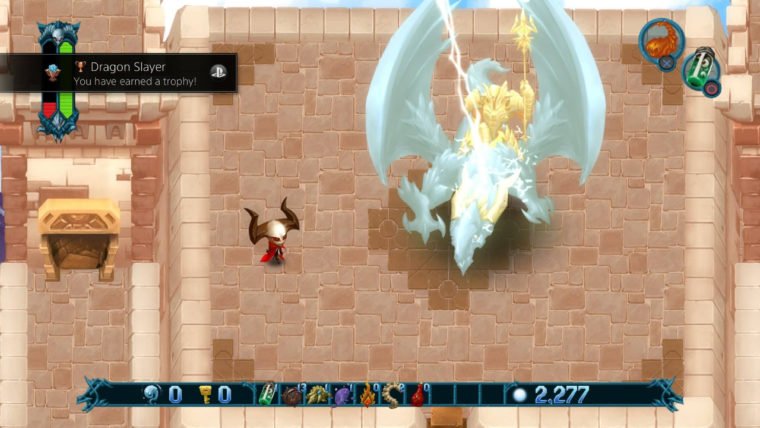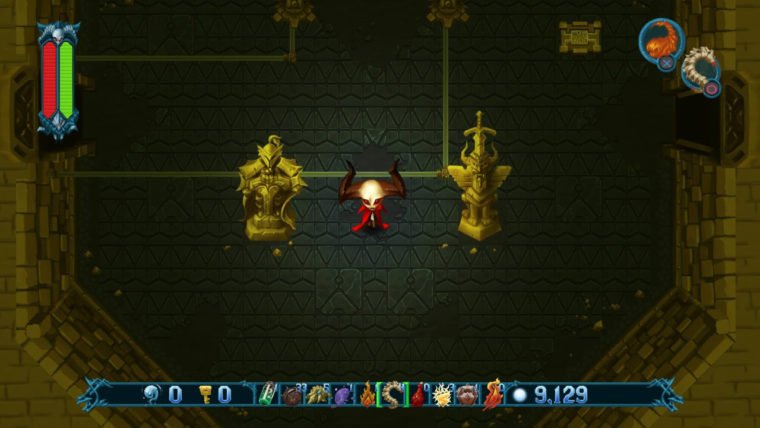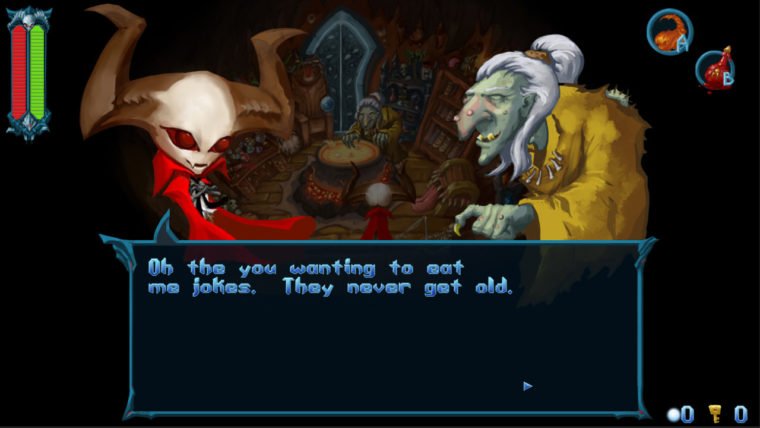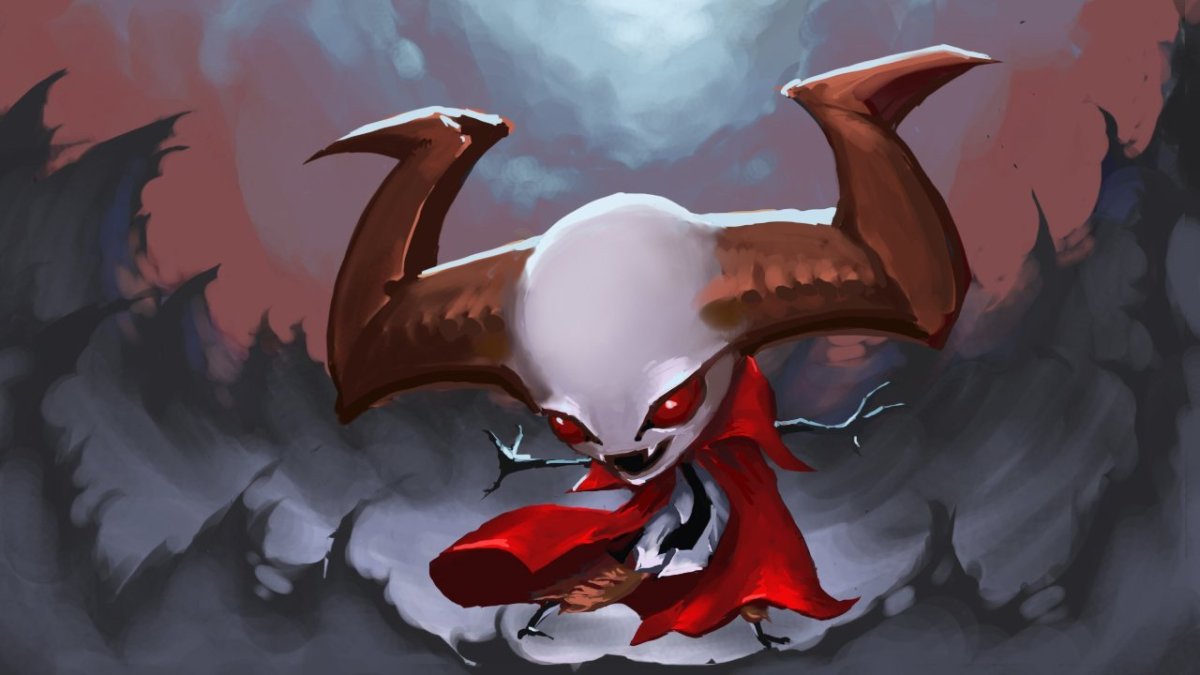Video games are obsessed with the idea of making you the hero. You stroll into town, find out about some nearby baddie that has been terrorizing the local populace, swing into action, and set everything right. It’s a formula that has worked for decades, but sometimes you want something a little different. Sometimes you want to be that baddie who is terrorizing the poor villagers. Sometimes, you just want to cause some trouble. That is where Rack N Ruin comes in, placing you in the role of the bad guy who has come to wreak havoc on the innocent townspeople. The game takes inspiration from gaming greats, such as Zelda and various action games. Unfortunately it squanders these homages, and its interesting premise with poor design decisions that take a lot of the fun out of the experience.
Rack N Ruin places you in the role of Rack, a demon who goes around conquering planets in the name of his leader, Ruin. Or, at least, that’s what he is supposed to do. Instead, he usually just obliterates the planet, leaving behind nothing but dead, floating asteroids. As Ruin points out, “asteroids don’t make for good slaves,” so he tasks Ruin with actually taking over a planet, as opposed to just destroying it. To do this he’ll have to explore the world, battle enemies, and generally cause chaos wherever possible.

It is certainly an interesting premise, having players essentially play through a Zelda game as the bad guy. However, a few missteps detract greatly from the enjoyment that the game could offer. The end result being that players will find themselves more frustrated than actually having fun with Rack N Ruin. The problems start right out of the gate, and compile as the game progresses.
Rack N Ruin features a vast, open world for players to explore. Sections are cordoned off if the player isn’t supposed to go there just yet. To unlock everything, and corrupt every area of the world, you’ll have to go on a quest. By exploring various dungeons around the world you will gain new abilities that let you progress through the story. While you do this you’ll be gathering up the souls of your defeated foes, which are used as currency, and as the method of finally corrupting each section of the map.
Exploring the world feels good at first, the beautiful, almost hand-drawn graphics pull you in, and the enjoyable music keeps you immersed. What takes you out of the experience are all of the ways that the map will trick you. It seems like the developers were too enamored with their own art, causing them to focus more on aesthetics than on the basic elements of map design. Parts of the map will be locked away with just a few tiny rocks scattered before you, yet completely necessary paths will be totally obscured by trees. At no point will players feel comfortable with their surroundings, always questioning whether they are missing some tiny detail that would lead them to the correct path.

This is especially troublesome since Rack N Ruin forgoes almost any type of hand holding or guidance. There’s a story here, so you’ll always get a quick conversation that points you in the next direction, but sometimes it’ll be as simple and open to interpretation as “go east”. Looking at the woefully unhelpful map will show you multiple areas to the east, and you’ll end up having to wander back and forth through each and every one of them before you stumble onto the next spot you are looking for.
Rack N Ruin’s dungeons are full of enemies and puzzles, both of which are not very enjoyable to interact with
This feeling of confusion and frustration translates into Rack N Ruin’s dungeons as well. Taking another queue from The Legend of Zelda, the game will task players with exploring and completing a few dungeons on their journey. These dungeons look and feel like they were ripped straight out of A Link to the Past, which would be perfectly acceptable if they followed that game’s excellent design philosophies.
Rack N Ruin’s dungeons are full of enemies and puzzles, both of which are not very enjoyable to interact with. The puzzles are the usual block movement type, and while a few strike the right balance between challenge and fun, many are so obscure that players will find themselves banging their head against the wall, trying to figure it all out. This isn’t a bad thing in and of itself though, in fact a tougher Zelda-style game would be a perfectly enjoyable experience, but again Rack N Ruin falters.

The biggest issue with the dungeons is that, if you die, almost everything resets to the beginning. Enemies fill up the dungeon once more, and almost any puzzle you solved will have to be redone if you need to traverse through that area again. If you are stuck on a puzzle, you’ll find yourself having to redo a large portion of the dungeon just to get back to where you were when you died. You’ll also end up battling the same enemies over and over again as they respawn immediately upon your death.
Almost every area or room in Rack N Ruin is full of enemies. Most of them aren’t too hard to defeat, but there are a ton of them, and you’ll have to dodge a lot of incoming fire. Unfortunately the combat mechanics simply aren’t up to snuff for a game that features this many enemies and requires this much maneuverability. Looking at the images and trailers, Rack N Ruin appears to be a twin-stick shooter, but instead you will use a lock-on mechanic, which doesn’t always work well.
Often times you’ll find that you are locked on to an element of the map, such as a switch or box, instead of the giant robot monster that is attacking you. Other times, there will be so many enemies that picking the one you actually want to hit first will be nearly impossible. Another annoyance of combat is that, if you get hit, you’ll stop firing. It is a simple adjustment to make, but when bullets are firing everywhere around you, all you can think about is holding the lock-on and attack buttons and maneuvering through the chaos. Realizing that you haven’t fired a shot in a while will always elicit a sigh of frustration. There are other weapons that mitigate these problems, such as the sword or lightning attacks, but they are only usable in certain situations, so you are almost always relying on your base fire spell.

The biggest problem with Rack N Ruin is one of incentives. Players need to be incentivized to do the things that the designers want them to do to progress in the game. But as you get further into the game you will pick up on patterns that make you not want to progress at all. Enemies spawn almost every time you solve a puzzle. Solving these puzzles, or finding some secret area, will almost always yield a simple reward like health or extra souls instead of a new, more powerful weapon. Instead of being excited about completing a puzzle, players will likely dread it, as they know that once they flip that final switch they will be bombarded with enemies, and their reward won’t really be worth it.
Rack N Ruin isn’t all bad though. As previously stated, the visuals and audio are quite enjoyable. The premise is fantastic, and really should have been capitalized on more. When it is used effectively, it can be a lot of fun, as Rack cracks jokes and is generally annoying to all those around him. Some of the writing could have been improved, and grammar and spelling errors don’t help the game that much, but it is fun when it works out.
The Verdict
Rack N Ruin is a game that copies from some of the best, but fails to understand what made those games work so well in the first place. Great visuals and audio combined with an intriguing premise help lift the game above total mediocrity, but terrible design decision bring it right back down. Luckily it is still copying from great games, so if you enjoy those you can find something to like here, but get ready for some extra frustration as well.








Published: Mar 31, 2015 09:32 am